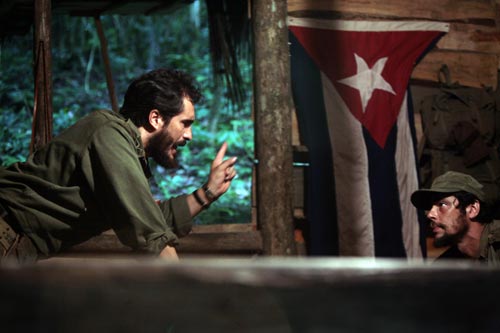
Director Steven Soderbergh has often alternated between big-budget Hollywood flicks (Out of Sight, Ocean’s 11) and smaller, indie fare (Schizopolis, Bubble). Che, his newest film, has elements of both. It has a big star in Benicio del Toro, a sexy topic in the life of Ernesto ‘Che’ Guevara, and an epic scope as Che helps to overthrow the Batista government of Cuba. But it’s also a small movie, as Soderbergh intentionally limits the film’s scale and focuses on the difficulties of creating a revolutionary movement.
This is particularly true in the movie’s second half, which skips ahead to 1966 when Che went to Bolivia in the hopes of replicating the success he had in Cuba. But as Soderbergh methodically shows, the circumstances were different in Bolivia. While the Cuban leftist political parties banded together with Castro and Che’s military movement, the communist party in Bolivia was skeptical and refused to lend support. While the Batista government was largely incompetent in how it ignored the revolution fomenting in the mountains, the Bolivian government, with the help of the CIA, didn’t make the same mistake. And while Che was able to work with a wide variety of charismatic leaders in Cuba, he was largely alone in Bolivia and was never able to create the momentum or sense of inevitability that occurred in the Cuban countryside.
As Soderbergh did in Traffic, he uses various film stocks and color schemes to separate the various storylines: Che in Mexico before heading to Cuba, Che in the jungles and hills of Cuba, Che speaking at the United Nations several years later. He even switches aspect ratios when the story moves to Bolivia. But once you get used to that framework, the story moves through its paces. Only a faux-overture feels the least bit postmodern.
Those unfamiliar with the Cuban Revolution will find much to learn here, though anyone relying on a movie for that kind of information is asking for superficiality. And while the movie isn’t out to make Che into some kind of saint, it doesn’t do anything to puncture the balloon of reverence many people feel for him. Benicio Del Toro is fine as Che, though I was surprised at how low-key his performance is. It’s certainly not Oscar-bait, for which I guess I should be grateful. And Soderbergh knows how to edit his footage together, keeping everything moving forward, never letting the audience lose track of the story.
But the film’s smallness works against it, especially in the second, Bolivian half. Soderbergh uses an interesting rhyming structure, so that we’re forced to notice the contrasts between the Cuban and Bolivian situations. But once a thoughtful viewer catches on to what Soderbergh is doing (and I did within a half hour of intermission), the rest becomes somewhat tedious. Yes, there’s a Malick influence in how Soderbergh shoots in the dry hills of Bolivia, but even that focus on nature isn’t enough.
I found the bigger, Cuban half more interesting, maybe in part because it’s a more traditional Hollywood tale, full of action and rousing camaraderie. But then I also tend to enjoy some of Soderbergh’s big-budget fare like Erin Brockovich and Out of Sight more than the esoteric Full Frontal and Schizopolis. What a philistine I am! Feel free to mock me at length.




I agree, J. Robert. (BTW, for those people who listen to podcasts, we talked about Che on Toronto recap.)
My favorite of Soderbergh's films is The Limey, a smallish thriller that's not a serious film, I guess, but one with enough thoughtful edges and confident style (inspired by Point Blank, but not simply a duplication of that film's structure) to keep me interested.
Soderbergh just showed a work-in-progress at Sundance, and I missed it, but a lot of our pals and acquaintances who saw it came out quite pleased.